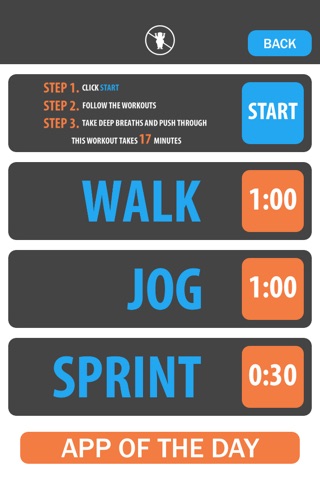
Dad Bod Destroyer - Get rid of your dad bod through short burst High Intensity Interval Training
The dad bod is something that is easily attainable, but until now, it has been hard to escape.
The dad bod occurs when a father is taking care of a child and simply forgets to take care of himself. Despite what the media may tell you, there is nothing sexy about the dad bod. It is nothing to be proud of. So it is time to destroy your dad bod!
While researching for this app, our team came across many forms of burning fat. If there is one style of working out that intrigued us, it is High Intensity Interval training (HIIT).
What is HIIT? High Intensity Interval Training or HIIT is a training technique in which you give all-out, one hundred percent effort through quick, intense bursts of exercise, followed by short, sometimes active, recovery periods. This type of training gets and keeps your heart rate up and burns more fat in less time.
This app includes 4 workouts:
1. Running - Start by walking, turn it into jogging, and then you will be sprinting in no time.
2. Biking - This is a lower impact option compared to running, but this workout is not to be taken lightly. Your heart rate will be high and you will be breaking a sweat!
3. Swimming - For those who like to keep it cool in the pool, swimming can really get your heart rate up while workout out your whole body.
4. Rowing - Have you ever seen those rowing machines at the gym and wondered what they are all about? Now is your chance to test one of those bad boys out. Fire up the rowing workout and watch your heart rate shoot through the roof.
High-intensity interval training can be described as an exercise session composed entirely of HIIT techniques, or as a component of an exercise plan. HIIT exercise sessions generally consist of a warm up period, then several repetitions of high intensity exercise separated by medium intensity exercise for recovery, then a cool down period. The high intensity exercise should be done at near maximum intensity. The medium exercise should be about 50% intensity. The number of repetitions and length of each depends on the exercise, but may be as little as three repetitions with just 20 seconds of intense exercise. The specific exercises performed during the high-intensity portions vary.
There is no specific formula to HIIT. Depending on ones level of cardiovascular development, the moderate-level intensity can be as slow as walking. A common formula involves a 2:1 ratio of work to recovery periods, for example, 30–40 seconds of hard sprinting alternated with 15–20 seconds of jogging or walking.
The entire HIIT session may last between four and thirty minutes, meaning that it is considered to be an excellent way to maximize a workout that is limited on time. Use of a clock or timer is recommended to keep accurate times, number of rounds and intensity.
Cardiovascular fitness
A 2015 systematic review and meta-analysis of randomized controlled trials found that HIIT training and traditional endurance training both lead to significantly improved cardiovascular fitness in healthy adults ages 18–45 but greater improvements in VO2 max were seen in those participating in the HIIT exercise regimen. Another analysis also found that HIIT regimens of one month or longer effectively improve cardiovascular fitness in adolescents and lead to moderate improvements in body composition. Furthermore, a separate systematic review and meta-analysis of seven small randomized controlled trials found that HIIT (defined as four intervals of four minutes at 85-95% of max heart rate with three-minute intervals at 60-70% of max heart rate) was more effective than moderate-intensity continuous training at improving blood vessel function and markers of blood vessel health.
Metabolic effects
HIIT significantly lowers insulin resistance compared to continuous training or control conditions and leads to modestly decreased fasting blood glucose levels and weight loss compared to those who do not undergo a physical activity intervention.



